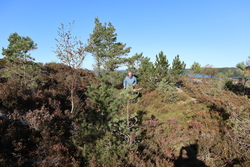Restoration of the coastal shrublands at Rapeneset
The ecosystem has begun to recover, and through continued collaboration we can restore the endangered heathland habitat.

Rapeneset is located on Radøy in the Alver municipality in Nordhordland in Norway. It stretches northwest along Fosnstraumen and Hoplandsosen from Straume. The area is about 400 decares in totality, or roughly 100 acres. In Hoplandsosen, Rapeneset borders Fosnøy in Austrheim municipality.
At Rapeneset there are more than 20 registered settlements from the Early Stone Age. Along with the discoveries of settlements on both sides of Fosnstraumen, it is considered to be one of the most valuable cultural remnants from the Early Stone Age in Northern Europe. The area at Rapeneset is made accessible via walking paths and trail markings and is classified by Radøy (Alver) municipality as a “very important” outdoor recreation area. Fosnstraumen has regional and national importance as an area for recreational fishing and freediving.
Heathlands and coastal moors are the dominant habitats found at Rapeneset. The heathlands, or coastal shrublands, are a rather endangered type of ecosystem that is at risk of disappearing due to reduced management and increased overgrowth. The heathlands at Rapeneset are registered of high local importance in the Natural Species Database (Naturdatabasen) maintained by the Norwegian Environment Agency (Miljødirektoratetet). A roughly six acre plot of mature Sitka spruce at the southeast edge of Rapeneset is leading to the spread of seeds and increasing overgrowth within the heathlands in the northwest of Rapeneset.
Naturvernforbundet Hordaland and Naturvernforbundet Nordhordland are working together to restore the heathlands along with landowners, local farmers, and Nordhordland Biosfæreområde IKS.
The goal of the restoration efforts is to ensure that these heathlands are protected, and that we guarantee habitats for species which live in the coastal shrublands. This is achieved via relatively low-touch management methods such as controlled grazing of sheep and burning of shrubs. By utilising these methods, the restoration efforts also contribute to local food production and traditional land management and farming practices. These ensure better carbon-binding and a more aesthetic landscape which adds to a more authentic experience among the remnants of the Stone Age settlements.
To achieve success with the project, clearing of overgrown areas by forestry contractors, clean-up of the forests and scrub areas via volunteer work, an all-around collaboration with the involved parties, and a good dose of volunteer spirit is needed. So roll up those sleeves, and join the team! Here there will be several opportunities for various activities in the upcoming future.
Translation by Julian Lee